
Amunet or Imnt is a primordial goddess in ancient Egyptian religion. Thebes was the center of her worship through the last dynasty, the Ptolemaic Kingdom, in 30 BCE. She is attested in the earliest known of Egyptian religious texts and, as was the custom, was paired with a counterpart who is entitled with the same name, but in the masculine, Amun. They were thought to have existed prior to the beginning of creation along with three other couples representing primeval concepts.

Mut was a mother goddess worshipped in ancient Egypt. Her name means mother in the ancient Egyptian language. Mut had many different aspects and attributes that changed and evolved greatly over the thousands of years of ancient Egyptian culture.

In Egyptian mythology, Sekhmet is a warrior goddess as well as goddess of medicine.
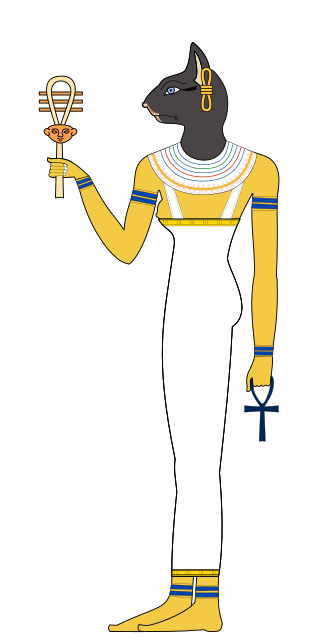
Bastet, also known as Ubasti, or Bubastis, is a goddess of ancient Egyptian religion possibly of Nubian origin, worshipped as early as the Second Dynasty. In ancient Greek religion, she was known as Ailuros.

Hathor was a major goddess in ancient Egyptian religion who played a wide variety of roles. As a sky deity, she was the mother or consort of the sky god Horus and the sun god Ra, both of whom were connected with kingship, and thus she was the symbolic mother of their earthly representatives, the pharaohs. She was one of several goddesses who acted as the Eye of Ra, Ra's feminine counterpart, and in this form, she had a vengeful aspect that protected him from his enemies. Her beneficent side represented music, dance, joy, love, sexuality, and maternal care, and she acted as the consort of several male deities and the mother of their sons. These two aspects of the goddess exemplified the Egyptian conception of femininity. Hathor crossed boundaries between worlds, helping deceased souls in the transition to the afterlife.
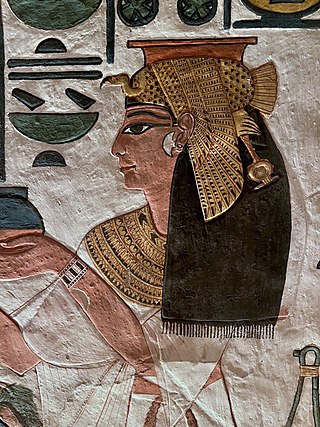
Nefertari, also known as Nefertari Meritmut, was an Egyptian queen and the first of the Great Royal Wives of Ramesses the Great. She is one of the best known Egyptian queens, among such women as Cleopatra, Nefertiti, and Hatshepsut, and one of the most prominent not known or thought to have reigned in her own right. She was highly educated and able to both read and write hieroglyphs, a very rare skill at the time. She used these skills in her diplomatic work, corresponding with other prominent royals of the time. Her lavishly decorated tomb, QV66, is one of the largest and most spectacular in the Valley of the Queens. Ramesses also constructed a temple for her at Abu Simbel next to his colossal monument there.

The Karnak Temple Complex, commonly known as Karnak, comprises a vast mix of temples, pylons, chapels, and other buildings near Luxor, Egypt. Construction at the complex began during the reign of Senusret I in the Middle Kingdom and continued into the Ptolemaic Kingdom, although most of the extant buildings date from the New Kingdom. The area around Karnak was the ancient Egyptian Ipet-isut and the main place of worship of the 18th Dynastic Theban Triad, with the god Amun as its head. It is part of the monumental city of Thebes, and in 1979 it was added to the UNESCO World Heritage List along with the rest of the city. Karnak gets its name from the nearby, and partly surrounded, modern village of El-Karnak, 2.5 kilometres north of Luxor.

The Eye of Ra or Eye of Re, usually depicted as sun disk or right wedjat-eye, is an entity in ancient Egyptian mythology that functions as an extension of the sun god Ra's power, equated with the disk of the sun, but it often behaves as an independent goddess, a feminine counterpart to Ra and a violent force that subdues his enemies. This goddess, also known with the theonym Wedjat, can be equated with several particular deities, including Hathor, Sekhmet, Bastet, Raet-Tawy, Menhit, Tefnut, and Mut. The eye goddess acts as mother, sibling, consort, and daughter of the sun god. She is his partner in the creative cycle in which he begets the renewed form of himself that is born at dawn. The eye's violent aspect defends Ra against the agents of disorder that threaten his rule. This dangerous aspect of the eye goddess is often represented by a lioness or by the uraeus, or cobra, a symbol of protection and royal authority. The disastrous fury and rampages of the eye goddess and the efforts of the gods to appease her are a prominent motif in Egyptian mythology.
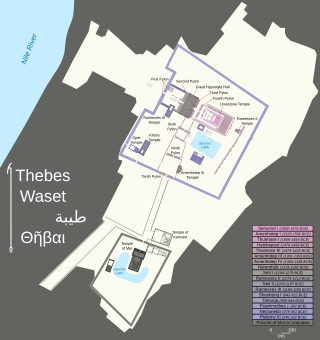
The Precinct of Mut is an Ancient Egyptian temple compound located in the present city of Luxor, on the east bank of the Nile in South Karnak. The compound is one of the four key ancient temples that creates the Karnak Temple Complex. It is approximately 325 meters south of the precinct of the god Amun. The precinct itself encompasses approximately 90,000 square meters of the entire area. The Mut Precinct contains at least six temples: the Mut Temple, the Contra Temple, and Temples A, B, C, and D. Surrounding the Mut Temple proper, on three sides, is a sacred lake called the Isheru. To the south of the sacred lake is a vast amount of land currently being excavated by Betsy Bryan and her team from the Johns Hopkins University in Baltimore, Maryland.

The Stele of Ankh-ef-en-Khonsu or Stele of Revealing is a painted, wooden offering stele located in Cairo, Egypt. It was discovered in 1858 by the French Egyptologist François Auguste Ferdinand Mariette at the mortuary temple of the 18th Dynasty Pharaoh Hatshepsut, located at Deir el-Bahari. It was originally made for the Montu-priest Ankh-ef-en-Khonsu i, and was discovered near his coffin ensemble of two sarcophagi and two anthropomorphic inner coffins. It dates to circa 680–70 BCE, the period of the late 25th Dynasty/early 26th Dynasty. Originally located in the former Boulaq Museum under inventory number 666, the stele was moved around 1902 to the newly opened Egyptian Museum of Cairo, where it remains today.

Mutnedjmet, also spelled Mutnodjmet, Mutnedjemet, etc., was an ancient Egyptian queen, the Great Royal Wife of Horemheb, the last ruler of the 18th Dynasty. The name, Mutnedjmet, translates as: "The sweet Mut" or "Mut is sweet." She was the second wife of Horemheb after Amenia who died before Horemheb became pharaoh.
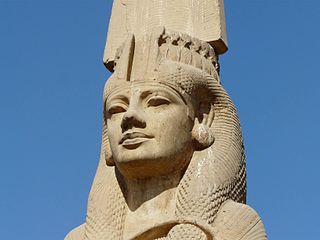
Meritamen was a daughter and later Great Royal Wife of Pharaoh Ramesses the Great, born by his first queen Nefertari.
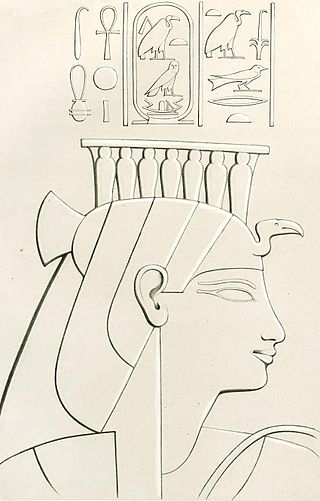
Mutemwiya was a minor wife of the Eighteenth Dynasty pharaoh Thutmose IV, and the mother of Pharaoh Amenhotep III. Mutemwiya's name means "Mut in the divine barque". While unconfirmed, it has been suggested that she acted as regent during the minority of her son Amenhotep III.

Werethekau was an ancient Egyptian deity. She served as the personification of supernatural powers.

Isetnofret was a royal woman of Ancient Egypt and, as the Great Royal Wife of Pharaoh Merenptah, she became Isetnofret II.

The Statue of Sekhmet currently housed in the Gallery of Ancient Egypt at the Royal Ontario Museum (ROM) is a life-sized sculpture of one of the oldest known Egyptian deities. Her name is derived from the Egyptian word "sekhem" and is often translated as the "Powerful One". Depicted as a woman with the head of a lioness – sometimes with the addition of a sun disc and the uraeus serpent atop her head – Sekhmet is the ancient Egyptian goddess of war who was believed to be a protector of Ma'at and of the Egyptian people. She was also associated with healing and medicine, and her priests were known for being trained doctors and surgeons of remarkable calibre.

Tjenenyet, alternatively Tenenet, Tjenenet, Zenenet, Tanenet, Tenenit, Manuel de Codage transliteration Tnn.t, was an ancient Egyptian goddess of childbirth and protection. She is mentioned in texts dating from the Ptolemaic period as well as in the Book of the Dead.
Nebtuwi is an ancient Egyptian goddess personifying fertility, wife of Khnum. Her name translates as "the lady of the fields." The cult centre of her was Latopolis. Functions of Nebtuwi were close to the functions of goddesses like Isis and Hathor. Subsequently, Nebtuwi's cult was gradually relegated to the cult of Neith. She was depicted as a lady with a vulture cap similar to the goddess Mut.

Amesemi is a Kushite protective goddess and wife of Apedemak, the lion-god. She was represented with a crown shaped as a falcon, or with a crescent moon on her head on top of which a falcon was standing. The clothing that Amesemi is seen wearing is a robe that is made from cloth and is worn over her undergarments. She is often seen wearing a short necklace with large beads. She is also depicted holding a second set of hands with her.



















